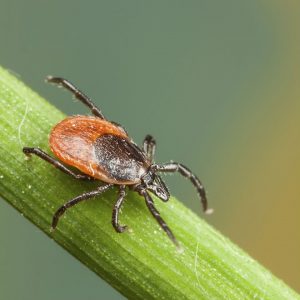As the weather warms up, that means more time outside with your dog. But, with the warm season, also means the return of something else: ticks.
Ticks are found specifically in longer grassy areas and in bushes. Even though many people think of them as insects, they are actually arachnids which are similar to spiders and mites. Ticks are parasites that feed off of the blood the host they attach themselves to. Those hosts can be can a human or an animal.
The biggest problem with ticks is that they are carriers of disease, specifically Lyme disease. Lyme disease can be very serious if not treated, with symptoms including a fever, loss of appetite, pain, lethargy, swollen lymph nodes, swollen joints and shifting lameness from one leg to another. If not treated, it can cause serious damage to your dog’s heart, nervous system and kidneys.
If you suspect that your pet has Lyme disease, take them to their vet as soon as possible. Your vet will want to do a blood panel to be sure and then start your dog on antibiotics right away as Lyme disease is a bacterial illness.
This is why it’s extremely important to do a tick check any time your dog has been outside, specifically if they have been in long grassy areas (such as the river valley) or in bushes. The most common places where ticks like to grab on to and most pet owners miss are your dogs ears, between their toes and arm pits.
What do you do if you find a tick on your dog? The safest way to remove a tick is by using a pair of fine tipped tweezers. Do not touch the tick with your bare hands as bacteria could be transmitted to you. Wear gloves or use a paper towel if you don’t have gloves. Grab the tick as close to the skin surface as possible so this reduces the chances of the head detaching. Pull the tick out with steady and even pressure. It may take a minute or two, so be patient. Once the tick has been removed, find a container and take it your vet so they can send it off to a lab to be inspected. Write down the time and place where the bite occurred. This helps vets and scientists know and understand if that tick carries Lyme disease.
Once the tick has been safely removed, it’s very important to disinfect the bite area and your hands as soon as possible.
So, what can you do to prevent your dog from getting ticks? Talk to your vet about what they recommend as there are many different options out there. There are monthly topical treatments that can be applied to your dog that are effective at keeping both ticks and fleas at bay. If your dog attends daycare, most daycare require proof that your dog is having it applied. But be cautious about using any random tick treatment you find at a store as they are not all created equal.
There are also oral medications, shampoos and even homeopathic/natural treatments. Like anything, talk to your vet to find the best course of preventative action.
Also, make sure you check yourself over if you have been out with your pet in high risk areas for ticks. You don’t want to take your chances.







